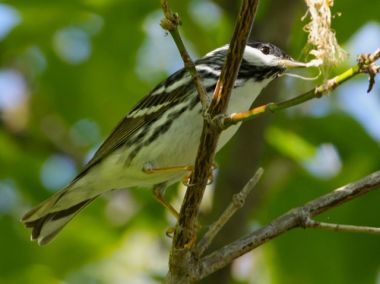 Those of you who read PABIRDS may remember how I reported hearing a blackpoll warbler in Schenley Park on April 30 and how I retracted my claim the next day. I decided to retract because I hadn’t actually seen the bird, I thought it was too early in the spring for a blackpoll to be in Pittsburgh, and the tree I heard it in was full of yellow-rumped warblers who can vary their songs a great deal.
Those of you who read PABIRDS may remember how I reported hearing a blackpoll warbler in Schenley Park on April 30 and how I retracted my claim the next day. I decided to retract because I hadn’t actually seen the bird, I thought it was too early in the spring for a blackpoll to be in Pittsburgh, and the tree I heard it in was full of yellow-rumped warblers who can vary their songs a great deal.
But now I’m back from four days at Magee Marsh, Ohio where the warblers come so close you could touch them. I saw and heard hundreds of warblers including quite a few blackpolls and yellow-rumps. I heard both warblers over and over again and now I have no doubt I heard a blackpoll on April 30.
As warbler song goes, the blackpoll’s is quite distinctive and I’ve never seen (emphasis on “seen”) another warbler sing it. The song is very high pitched, all on one note and very rhythmic: zeet zeet zeet zeet zeet zeet. It sounds like a squeaky bicycle brake on a fast-moving bike, a similarity I noticed when I first heard these warblers at Presque Isle State Park. I was standing in the middle of the bike lane at the time and thought I was hearing a bike braking to avoid hitting me. I jumped out of the way – and no bike was there. I looked up and saw the blackpoll singing.
Blackpolls winter in South America and breed in the coniferous forests of Canada and Alaska. They’re called blackpolls because their “poll” (the crown of their heads) is all black. They have black and white striped wings, white faces and bellies and bright orange-yellow legs. Compared to hyperactive warblers like the American redstart they’re usually easy to observe – once you find them – because they don’t jump around a lot.
The blackpoll is notable for its astonishing fall migration route. Every fall they mass on the coast of North America and wait for a very strong north wind. When it comes, they launch themselves over the Atlantic and fly non-stop to South America. The journey takes 88 hours, first sending them far offshore to the east, then southwest on the trade winds which push them back toward land. Many of them return by the overland route, taking their time to move north as spring comes to our continent. Their slow progress gives them the appearance of being “late” migrants, but it’s just that they linger.
So I reinstate my blackpoll to good standing. So what if he was early. He was there.
(photo by Chuck Tague)